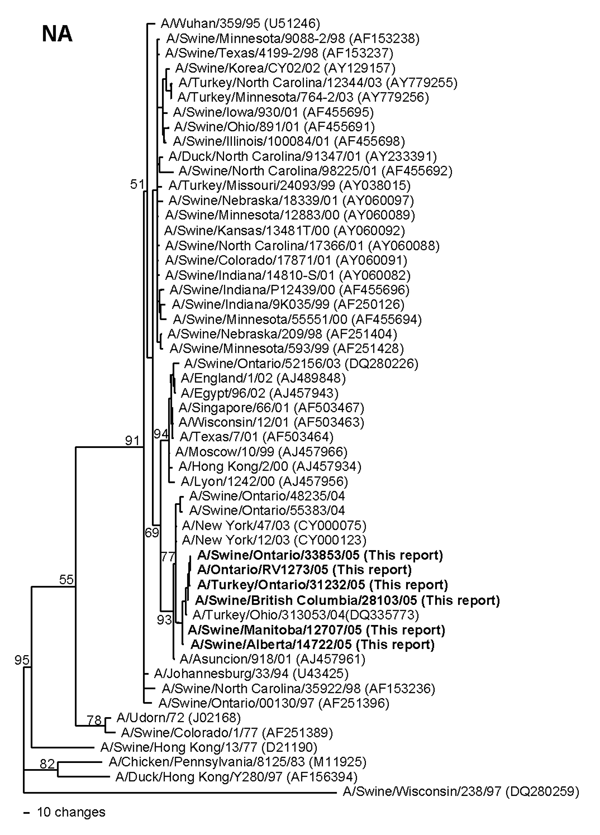Triple Reassortant H3N2 Influenza A Viruses, Canada, 2005
Christopher W. Olsen*

, Alexander I. Karasin*, Suzanne Carman†, Yan Li‡, Nathalie Bastien‡, Davor Ojkic†, David Alves§, George Charbonneau¶, Beth M. Henning#, Donald E. Low**, Laura Burton**, and George Broukhanski**
Author affiliations: *University of Wisconsin-Madison, Madison, Wisconsin, USA; †Animal Health Laboratory, Guelph, Ontario, Canada; ‡Canadian Science Centre for Human and Animal Health, Winnipeg, Manitoba, Canada; §Ontario Ministry of Agriculture, Food, and Rural Affairs, Guelph, Ontario, Canada; ¶Swine Services Group, Stratford, Ontario, Canada; #Ontario Ministry of Health and Long Term Care, Clinton, Ontario, Canada; **Ontario Ministry of Health and Long Term Care, Toronto, Ontario, Canada
Main Article
Figure 2

Figure 2. Nucleotide phylogram for the neuraminidase (NA) genes of A/Swine/Manitoba/12707/05, A/Swine/Alberta/14722/05, A/Swine/British Columbia/28103/05, A/Swine/Ontario/33853/05, A/Turkey/Ontario/31232/05, A/Ontario/RV1273/05, and related reference viruses. The evolutionary relationships among these viruses were estimated by the method of maximum parsimony (PAUP software, version 4.0b10) with a bootstrap resampling method (200 replications) and a fast heuristic search algorithm. Numbers at the nodes of the phylograms indicate the bootstrap confidence levels. Horizontal-line distances are proportional to the minimum numbers of nucleotide changes needed to join nodes and gene sequences. Vertical lines are present to space the branches and labels. GenBank accession numbers for the sequences of all reference viruses are provided in parentheses after the virus names.
Main Article
Page created: December 19, 2011
Page updated: December 19, 2011
Page reviewed: December 19, 2011
The conclusions, findings, and opinions expressed by authors contributing to this journal do not necessarily reflect the official position of the U.S. Department of Health and Human Services, the Public Health Service, the Centers for Disease Control and Prevention, or the authors' affiliated institutions. Use of trade names is for identification only and does not imply endorsement by any of the groups named above.
